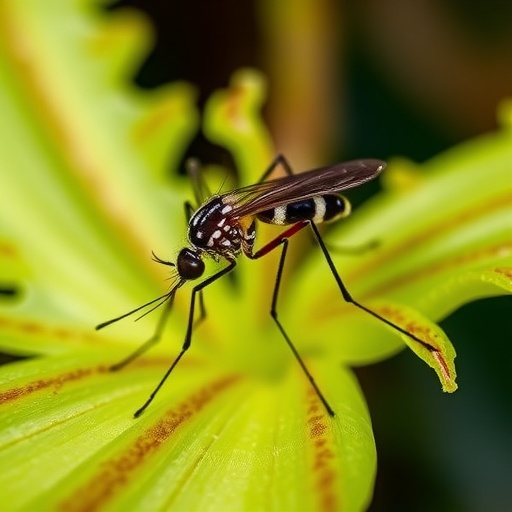In the mid-20th century, malaria transmission by the mosquito species Anopheles cruzii in Brazil’s South and Southeast regions reached alarming heights, with infection rates soaring to approximately 4,000 cases per 100,000 inhabitants in the 1940s. This intense prevalence earned the disease the moniker “bromeliad malaria,” a reference to the unique breeding ecology of the vector. Anopheles cruzii belongs to the Kerteszia subgenus, whose larval stages are intimately linked to bromeliads—epiphytic plants capable of accumulating water within their leaf tanks. These water reservoirs create microhabitats that facilitate mosquito development, providing ideal environmental conditions such as temperature, oxygen levels, and pH balance critical for larval survival and growth.
Despite malaria becoming a minor public health concern in these Atlantic Forest regions today, sporadic cases persist, with 77 confirmed infections reported in São Paulo state between 2017 and early 2024 alone. This status underscores the importance of rigorous scientific inquiry into the ecology of malaria vectors and the abiotic variables that sustain their populations. Such understanding is pivotal for preempting potential outbreaks and curtailing the disease’s resurgence, particularly given the proximity of the Amazon basin where malaria remains endemic.
A recent comprehensive study spearheaded by researchers at the University of São Paulo’s School of Public Health (FSP-USP) offers fresh insights into the complex relationships among environmental factors, bromeliad water conditions, and mosquito assemblage structures in the Capivari-Monos Environmental Protection Area. Conducted over two years, the study meticulously monitored larvae inhabiting nine individual bromeliad plants situated in different points within this protected area to discern how fluctuations in rainfall and temperature modulate water volume and quality within these microhabitats.
The investigative team employed robust statistical models to delineate a cascade of ecological effects initiated by abiotic drivers. Initially, their analyses revealed that accumulated rainfall and mean monthly temperatures significantly influence the volume of water retained by bromeliads. Subsequently, this fluctuating water volume impacts key physicochemical parameters, including pH levels, salinity, and dissolved oxygen content—all factors crucial to larval mosquito development and species composition.
Crucially, the data demonstrated that these changing physicochemical characteristics, driven by climate variables, affect mosquito assemblage dynamics within bromeliad tanks. The researchers found a total of 523 mosquito specimens spanning 23 species, encompassing genera such as Anopheles (including the malaria vector A. cruzii), Culex, and Wyeomyia. While Culex and Wyeomyia mosquitoes are not implicated in malaria transmission, their high numbers can contribute to ecological imbalance and cause nuisance to local populations due to increased biting activity.
Further statistical scrutiny revealed that among environmental variables, pH consistently bore the strongest correlation with the presence and abundance of nearly half the mosquito species surveyed, including A. cruzii. Moreover, interactions between pH and salinity further influenced community composition, underscoring the nuanced ways in which abiotic conditions shape vector ecology. These findings have profound implications for anticipating shifts in vector populations in response to climate variability.
The study also contextualizes these ecological dynamics within the broader scope of climate change projections. Models suggest that altered rainfall regimes and temperature elevations could either amplify or suppress malaria vector populations depending on regional specifics. For instance, East African and certain South American areas might become more conducive to transmission, whereas traditional endemic zones might see declines due to excessive heat. This complexity highlights the necessity of localized ecological understanding akin to the bromeliad vector system in the Atlantic Forest.
From a public health perspective, the control of Anopheles cruzii presents distinct challenges. Unlike urban vectors such as Aedes aegypti, which breed in artificial containers and can be targeted with insecticides and habitat removal, A. cruzii occupies natural, protected bromeliad habitats where chemical interventions are neither feasible nor ecologically advisable. Historical strategies involving bromeliad destruction during malaria outbreaks in the Southeast serve as cautionary tales, emphasizing the need for alternative environmental management approaches that respect biodiversity conservation.
Natural biological controls, including predation and interspecific competition, likely moderate mosquito populations within these bromeliads, potentially dampening dramatic vector surges despite environmental changes. Such ecological resilience, however, should not engender complacency. Ongoing, detailed surveillance remains vital to identify early signs of vector population shifts that could herald increased transmission risk.
Additionally, the zoonotic dimension of malaria in the Atlantic Forest complicates epidemiological control efforts. The disease may circulate between non-human primates, notably howler monkeys, and mosquitoes, forming sylvatic cycles that human populations can unwittingly breach. This wildlife reservoir creates a continuing source of infection, demanding integrated approaches that encompass wildlife monitoring alongside vector ecology.
While this study does not predict an imminent malaria outbreak in the Southeast, it crucially illuminates how environmental factors influence vector communities, providing a valuable framework for anticipating future trends. Given the accelerating pace of climate change, deforestation, urban expansion, and biodiversity loss, public health authorities must remain vigilant. Proactive monitoring and ecologically informed risk assessments will be indispensable tools in mitigating potential malaria resurgence in Brazil’s Atlantic Forest biome.
The interconnection between abiotic environmental factors and vector ecology accentuated by this research marks a significant contribution to our understanding of mosquito-borne diseases within complex ecosystems. By bridging entomology, climatology, and epidemiology, the study sets a precedent for multidisciplinary approaches necessary to confront emerging infectious disease challenges in the Anthropocene.
Subject of Research: Ecology of malaria vectors (Anopheles cruzii) and the influence of abiotic environmental factors on mosquito assemblage dynamics in bromeliads.
Article Title: Linking abiotic conditions to mosquito assemblage structure in bromeliads
News Publication Date: 19 August 2025
Web References:
https://www.nature.com/articles/s41598-025-15514-7
References:
Sousa, A.R.M. de, et al. (2025). Linking abiotic conditions to mosquito assemblage structure in bromeliads. Scientific Reports. DOI: 10.1038/s41598-025-15514-7
Keywords: Tropical forests, Infectious disease transmission, Epidemiology, Rain, Climate change effects




